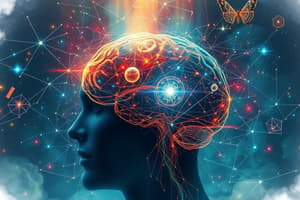Podcast
Questions and Answers
What is sensation?
What is sensation?
The process by which our sensory receptors and nervous system receive and represent stimulus energies from our environment.
What is perception?
What is perception?
The process of organizing and interpreting sensory information.
What is bottom-up processing?
What is bottom-up processing?
Analysis that begins with the sensory receptors and works up to the brain's integration of sensory information.
What is top-down processing?
What is top-down processing?
What is selective attention?
What is selective attention?
What is inattentional blindness?
What is inattentional blindness?
What is change blindness?
What is change blindness?
What is transduction?
What is transduction?
What is psychophysics?
What is psychophysics?
What is absolute threshold?
What is absolute threshold?
What is signal detection theory?
What is signal detection theory?
What is subliminal?
What is subliminal?
What is priming?
What is priming?
What is difference threshold?
What is difference threshold?
What is Weber's law?
What is Weber's law?
What is sensory adaptation?
What is sensory adaptation?
Flashcards are hidden until you start studying
Study Notes
Sensation and Perception Concepts
- Sensation involves the process where sensory receptors receive and represent environmental stimulus energies, transmitting this information to the brain.
- Perception is the organization and interpretation of sensory information, allowing recognition of meaningful objects and events.
Processing Types
- Bottom-up processing starts with sensory receptors and works up to the brain's higher-level integration of sensory input.
- Top-down processing is guided by higher-level mental processes, constructing perceptions based on experience and expectations.
Attention Mechanisms
- Selective attention focuses conscious awareness on a specific stimulus while ignoring others.
- Inattentional blindness occurs when individuals fail to see visible objects when attention is directed elsewhere, exemplified by the basketball video with players in different colored shirts.
- Change blindness refers to the failure to notice changes in the environment.
Energy Conversion and Perception
- Transduction is the conversion of physical stimulus energy (like sights or sounds) into neural impulses the brain can interpret.
- Psychophysics studies the relationship between physical characteristics of stimuli and the psychological experiences derived from them.
Thresholds and Detection
- Absolute threshold is the minimum stimulation needed to detect a particular stimulus 50% of the time, such as in hearing tests.
- Signal detection theory predicts how and when a faint stimulus can be detected amidst background noise, influenced by experience, expectations, motivation, and alertness.
- Subliminal stimuli are below the absolute threshold for conscious awareness, implying they cannot be detected 50% of the time.
Influence of Associations
- Priming activates certain associations, often unconsciously, which predisposes perceptions, memories, or responses to stimuli.
- The difference threshold (just noticeable difference or jnd) is the minimum difference required between two stimuli for detection 50% of the time.
Key Laws and Adaptation
- Weber's law states that for stimuli to be perceived as different, they must differ by a constant minimum percentage, not a constant amount.
- Sensory adaptation refers to diminished sensitivity due to constant stimulation, allowing individuals to focus on changes in their environment.
Studying That Suits You
Use AI to generate personalized quizzes and flashcards to suit your learning preferences.



